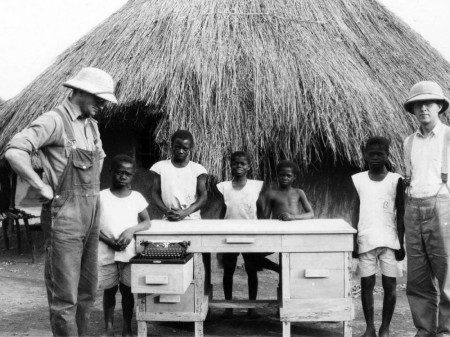“Tonight a vision came into my mind. I will write it here just as I was prompted to write it when I saw the vision….” – Ernest Weinhardt (October 17, 1929)

In the western Sudan of Africa, slightly-built, brown-haired, blue-eyed Ernest Weinhardt sat at his rough wooden table recording in his slanted handwriting the conviction from God which had gripped his soul.
Outside a brilliant moon sharply outlined the trees: a thick-trunked baobab tree, its sprawling root-like branches naked of leaves; the flowering acacias; the feathery jacarandas; and the thorn trees, their tiny-leaved branches arching in the shape of a huge umbrella. A gentle, cool breeze drifted through the window. Darkness had brought welcome relief after the heat of the day. A short while earlier the muezzin’s call to prayer had echoed out from the minaret of a local mosque. But this night Ernest Weinhardt was oblivious to it all. He reached over to pull his kerosene lamp a little closer. Head bent over his journal, he wrote and wrote:
And the Lord answered me: “Write the vision; make it plain upon tablets, so that he may run who reads it. For still the vision awaits its time; it hastens to the end – it will not lie. If it seems slow, wait for it; it will surely come, it will not delay.” What is the vision?
- That God will take out of the Lutheran church a large number of men and women as missionaries to bring his gospel to the great unoccupied areas of the world;
- That these be taken out directly by him, independently of and without the intervention of ecclesiastical organizations;
- That these be provided for materially directly by his intervention, in answer to prayer and according to his promises;
- That these be received directly in answer to prayer and in numbers corresponding to the need of the field or fields from time to time;
- That these missionaries occupy, as far as pleasing in the sight of God, the yet unreached territories in the hearts of three continents: Africa, Asia and South America;
- That these missionaries be preeminently men and women of the Cross, of the Spirit, of the Word and of prayer; having no desire other than to live, labor, suffer and die, if need be, for their Savior Jesus Christ;
- That these men and women occupy these territories with the primary purpose of praying for the outpouring of his Holy Spirit upon their peoples unto the conviction of sin and conversion;
- That this work be looked upon as a definite task to be completed within a definite period of time;
- That this work take on such a spirit and proportion to eventually involve all the Lutheran churches in America;
- That this be a mighty factor in uniting the believers of the various synods of the Lutheran church in one heart, mind and spirit around the God who has so manifestly worked in our behalf; …that these things be a source of quickening and blessing to other churches in the homeland as well;
- That these things be a mighty testimony to God as the true, living and almighty God, and as to the One who hears and answers the prayers of humble believers when offered in Jesus’ name and for Jesus’ sake; that these things be to the great glory of his name in the church and to Christ Jesus to all generations for ever and ever;
- That he accomplish the substance of these things according to his purpose, wisdom and will directly by the might of his own hand, exceeding abundantly above all that we ask or think, according to the power at work within us, in Jesus’ name and for Jesus’ sake.
On the next page Weinhardt sketched a crude map of the world and indicated the heart of Africa, Asia and South America. Below the map he wrote: “Can God do these things? Yes. Can he provide and send out needed missionaries – one thousand, two thousand? Yes. Can he supply the means? Yes.”
All of these thoughts had been churning around in Weinhardt’s mind and heart for years before that night in the African Sudan when he committed his vision, in orderly fashion, to paper.
True, the vision which he saw was not totally new. For many decades, all over the world, Christians from different denominations had caught a similar vision and had sought to implement it. But the vision came to Ernest Weinhardt with freshness and impact, especially as he foresaw it being fulfilled through the church of his confession, the Lutheran church.
Gladly he embraced the call.